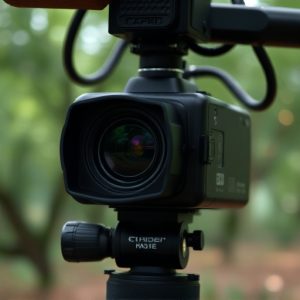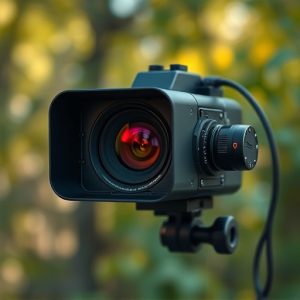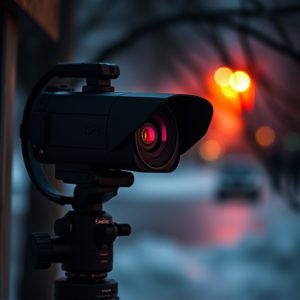Unveiling Hidden Threats: RF Detector Sweep for Invisible IR Cameras
RF detectors are vital tools for identifying invisible IR cameras used in home monitoring, which tra…….
RF detectors are vital tools for identifying invisible IR cameras used in home monitoring, which transmit signals through wires or wireless connections. By scanning and analyzing these signals, users can locate covert surveillance equipment, ensuring privacy and security. To detect these cameras, prepare your environment, equip yourself with a calibrated RF detector, and systematically search areas, focusing on entry points and unusual devices. Regularly update detectors and conduct periodic checks for proactive protection against intruders.
Uncover the secrets hidden within your surroundings with our comprehensive guide on RF detector sweeps for invisible IR cameras. In today’s world of advanced surveillance, understanding how to identify and mitigate these covert devices is crucial for home monitoring. This tutorial delves into the technology behind RF detectors, infrared camera detection, and step-by-step procedures for conducting effective sweeps. Ensure your peace of mind by learning the essentials of home security in the digital age.
- Understanding RF Detectors and Their Role in Camera Detection
- Identifying Invisible IR Cameras: The Basics of Infrared Technology
- Setting Up Your Environment for a Detector Sweep
- Step-by-Step Guide: Conducting the RF Detector Sweep
- Analyzing Results and Ensuring Home Security
Understanding RF Detectors and Their Role in Camera Detection
RF (Radio Frequency) detectors play a pivotal role in detecting hidden cameras, especially those using invisible IR (Infrared) technology for home monitoring. These devices operate by scanning and analyzing radio signals, which are often emitted by various household objects but can also be used by covert surveillance equipment. By pinpointing these signals, RF detectors help users locate hidden cameras that might be capturing personal spaces without consent.
In the context of home monitoring, understanding how RF detectors function is crucial. Invisible IR cameras, designed to remain undetected, transmit signals through wires or wireless connections. RF detectors, however, can intercept these transmissions, alerting users to the presence of such devices. This technology empowers individuals to safeguard their privacy and security by identifying potential threats from hidden surveillance equipment in their homes.
Identifying Invisible IR Cameras: The Basics of Infrared Technology
Infrared (IR) technology has become a game-changer in home monitoring, allowing for the detection of devices that are invisible to the naked eye, such as hidden infrared cameras. These cameras operate in the IR spectrum, which is beyond human visible light perception, making them particularly useful for covert surveillance. By utilizing specialized equipment like RF detectors with sweep capabilities, individuals can uncover these clandestine devices.
The basic principle behind identifying an Invisible IR Camera involves detecting the heat signature or electromagnetic radiation emitted by the camera’s sensors. Infrared cameras capture and convert this infrared energy into visible images, providing a clear view of what traditional cameras cannot. For home monitoring purposes, RF detector sweeps are effective in pinpointing these hidden cameras, ensuring privacy and security for individuals concerned about covert surveillance within their living spaces.
Setting Up Your Environment for a Detector Sweep
Before you begin your detector sweep, ensuring your environment is set up correctly is paramount. Start by identifying and marking potential entry points around your home or office space, such as windows, doors, and vents. These are common locations where an invisible IR camera might be hidden. Next, gather all necessary equipment: your RF (radio frequency) detector, batteries, and protective gear. Ensure the detector is properly calibrated and charged to maximize its sensitivity during the sweep.
Create a systematic search pattern, dividing your space into manageable sections. This approach ensures you cover every nook and cranny thoroughly. As you move from one area to another, keep an eye out for any unusual devices or signs of tampering. Remember, hidden IR cameras can be tiny and discreetly placed, so meticulous observation is key.
Step-by-Step Guide: Conducting the RF Detector Sweep
To conduct an effective RF (Radio Frequency) detector sweep for hidden cameras, especially those employing invisible IR (Infrared) technology for home monitoring, follow this step-by-step guide. Begin by ensuring your RF detector is fully charged and calibrated. Next, familiarize yourself with the device’s frequency range and sensitivity settings, as these will determine the effectiveness of your scan. Turn off all wireless devices in your home to minimize interference, as even everyday items can emit radio signals that could mask hidden camera transmissions.
Start your sweep from a central location within the area you wish to monitor, moving in systematic patterns. As you traverse, observe any fluctuations or anomalies on the detector’s screen. These could indicate the presence of a hidden camera. If an area shows consistent activity, zero in on it using a portable antenna for more precise detection. Remember, hidden cameras often operate on specific frequencies, so pinpointing these signals can help you identify the device. Regularly check and update your RF detector’s firmware to ensure optimal performance throughout your home monitoring process.
Analyzing Results and Ensuring Home Security
After conducting an RF detector sweep with an invisible IR camera for home monitoring, it’s crucial to analyze the results thoroughly. This involves identifying any unusual signals or readings that could indicate the presence of hidden cameras or other surveillance devices. By understanding the data collected, homeowners can pinpoint potential security breaches and take appropriate actions.
Ensuring home security goes beyond the initial scan. Regular checks using the IR camera are essential to maintain a safe environment. It’s recommended to set up a periodic monitoring schedule and familiarize yourself with the camera’s features, such as its sensitivity settings and field of view. This proactive approach allows for better protection against potential intruders or unauthorized devices, ensuring peace of mind in your own home.
In today’s digital era, ensuring home security has never been more crucial. With the rise of advanced technology, such as invisible IR cameras, understanding how to detect them is essential for effective home monitoring. By familiarizing yourself with RF detectors and their role in identifying hidden cameras, you can take proactive steps towards safeguarding your personal space. The step-by-step guide provided offers a practical approach to conducting an RF detector sweep, allowing you to stay one step ahead of potential privacy breaches. Remember that staying informed and equipped is key to maintaining a secure environment.


